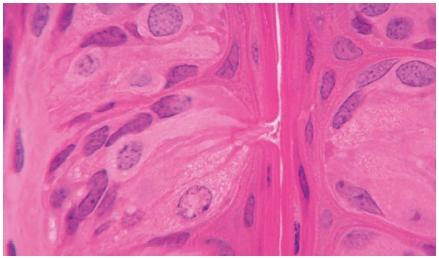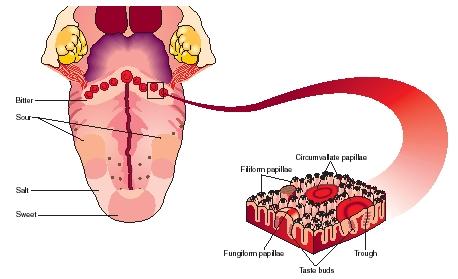Taste

Taste is one of the five senses through which all animals interpret the world around them. (The other senses are smell, touch, sight, and hearing.) Specifically, taste is the sense for determining the flavor of food and other substances. It is one of the two chemical senses (the other being smell) and it is stimulated when taste buds on the tongue come in

contact with certain chemicals. The sense of taste also is influenced by the smell and texture of substances, hereditary factors, culture, and familiarity with specific taste sensations.
The biology of taste
Clusters of small organs called taste buds are located in the mouth, mainly on the surface of the tongue. Taste buds (named so because under the microscope they look similar to plant buds) lie in small projections called papillae and contain taste receptors that bind to food molecules broken down by saliva. These receptors send messages along nerves to the brain, which interprets the flavor as sweet, sour, salty, or bitter.
Taste buds for all four taste groups can be found throughout the mouth, but specific kinds of buds are clustered together in certain areas. Sweetness is detected by taste buds on the tip of the tongue. The buds for sour tastes are on the sides of the tongue, and for salty toward the front. Bitter taste buds on the back of the tongue can make people gag, a natural defense mechanism to help prevent poisoning.
New taste buds are produced every three to ten days to replace the ones worn out by scalding or frozen foods. As people grow older, their

taste buds are replaced at a slower rate, and more of a substance is needed to experience its full flavor. Scientists have discovered that individual tasting abilities and preferences for specific foods are partially hereditary. Some people are genetically programmed to have more taste buds than others and, as a result, taste more flavors in a particular food. Additionally, culture and familiarity with foods greatly influence taste preferences. Foods that are a tradition in certain cultures may be unappealing to those who are unfamiliar with them. A taste for a particular food usually develops as a person consumes it more frequently.
The smell, texture, and temperature of foods also affect taste. People often first experience the flavor of a food by its odor. When a person's sense of smell is decreased due to congestion from a cold or flu, they frequently experience a reduced ability to taste. Some people will not eat pears because of the fruit's gritty texture, while others would not think of drinking cold coffee.
Taste disorders
Taste disorders, in which either the sense of taste or smell is impaired, can be the result of allergies and viral or bacterial infections that produce swollen mucus membranes (behind the nose). They also may be due to a brain injury or disease that permanently damages the neural pathway through which taste and smell is transmitted. In addition, exposure to environmental toxins such as lead, mercury, and insecticides can damage taste buds and sensory cells in the nose or brain.
The inability to taste or smell not only robs an individual of certain sensory pleasures, it also can be dangerous. Without smell or taste, people cannot determine whether food is spoiled, making them vulnerable to food poisoning. Also, some psychiatrists believe that a lack of taste and smell affects the quality of a person's life and can lead to depression.
[ See also Perception ]
I am a student studying at the University of KwaZulu Natal Pietermaritzburg, South Africa and am doing a power point talk on liver disease. Please could I use the image uesc_10_img0562.jpg found at the following web address http://www.scienceclarified.com/Sp-Th/Taste.html to illustrate the talk. The image is of an animated illustration of the various taste areas on the tongue.
Thank you for considering this matter.
Chantal David